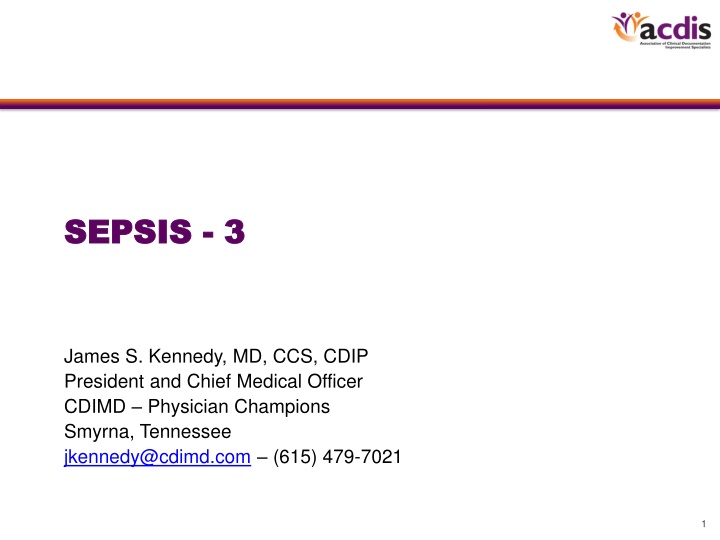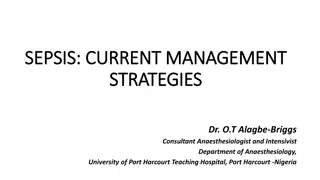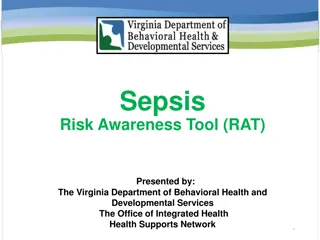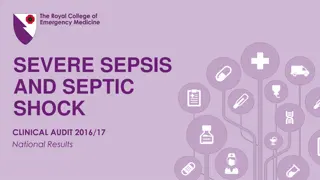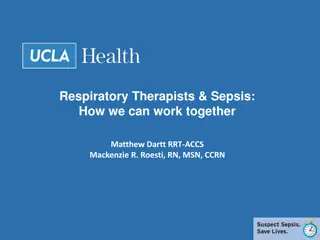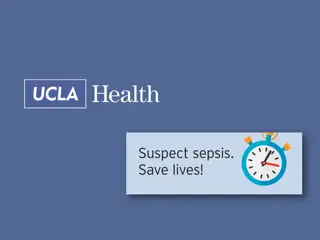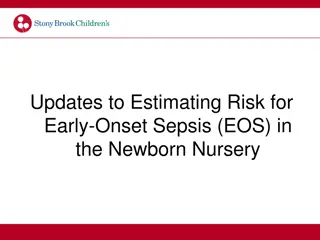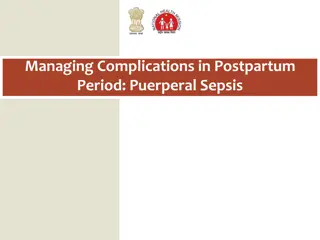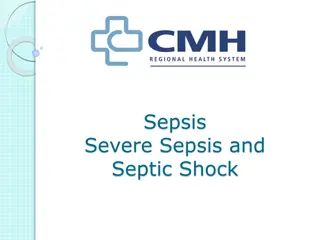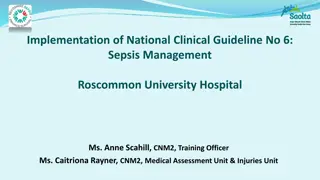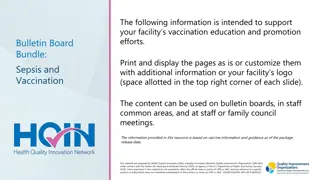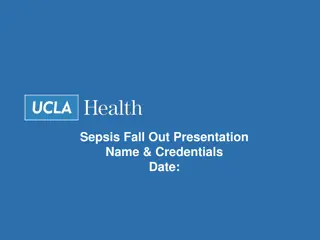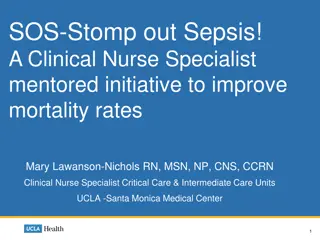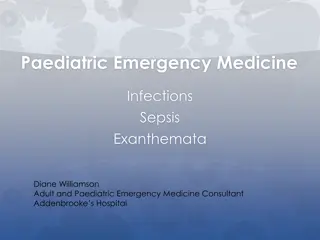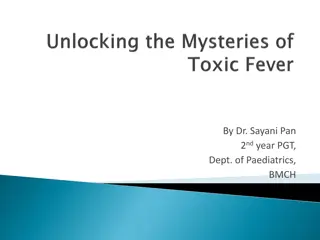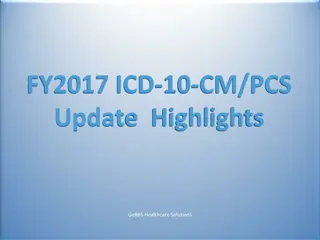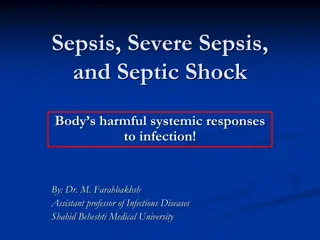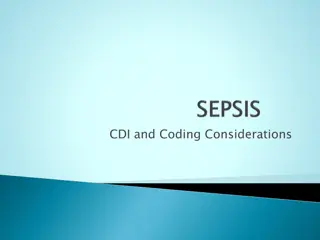Sepsis Redefinition: Key Changes and Criteria Overview
The redefinition of sepsis in 2016 brought significant changes in criteria, emphasizing life-threatening organ dysfunction due to infection. The removal of SIRS criteria and inclusion of SOFA score as a key element redefine sepsis and septic shock diagnosis and management.
Download Presentation

Please find below an Image/Link to download the presentation.
The content on the website is provided AS IS for your information and personal use only. It may not be sold, licensed, or shared on other websites without obtaining consent from the author.If you encounter any issues during the download, it is possible that the publisher has removed the file from their server.
You are allowed to download the files provided on this website for personal or commercial use, subject to the condition that they are used lawfully. All files are the property of their respective owners.
The content on the website is provided AS IS for your information and personal use only. It may not be sold, licensed, or shared on other websites without obtaining consent from the author.
E N D
Presentation Transcript
SEPSIS SEPSIS - - 3 3 James S. Kennedy, MD, CCS, CDIP President and Chief Medical Officer CDIMD Physician Champions Smyrna, Tennessee jkennedy@cdimd.com (615) 479-7021 1
Sepsis Redefinition (Sepsis-3) February 23, 2016 Announced at the SCCM meeting in Orlando on February 22, 2016 Published in JAMA on February 23, 2016 http://www.tinyurl.com/2016sepsis 2
Sepsis Redefinition February 23, 2016 Sepsis is now defined as a life-threatening organ dysfunction due to a dysregulated host response to infection In this new definition the concept of the non- homeostatic host response to infection is strongly stressed while the SIRS criteria have been removed The inflammatory response accompanying infection (pyrexia, neutrophilia, etc) often represent an appropriate host response to any infection, and this may not necessarily be life-threatening. 3
Sepsis Redefinition February 22, 2016 Septic shock is now defined as a subset of sepsis where underlying circulatory and cellular/metabolic abnormalities are profound enough to substantially increase mortality . Clinical criteria identifying such condition include the need for vasopressors to obtain a MAP 65mmHg AND an increase in lactate concentration > 2 mmol/L, despite adequate fluid resuscitation.* This new definition is mainly focused on the importance to both distinguish septic shock from other forms of circulatory shock and underline the detrimental clinical impact of sepsis-induced cellular metabolism abnormalities.* * Doesn t mean one can t have other forms of shock (e.g. cardiogenic, hypovolemic, or obstructive shock); if these are present, then they should be documented. 4
Sepsis Redefinition February 23, 2016 The key element of sepsis-induced organ dysfunction is defined by an acute change in total SOFA score 2 points consequent to infection, reflecting an overall mortality rate of approximately 10% The baseline Sepsis-related Organ Failure Assessment (SOFA) score may be taken as zero unless the patient is known to have previous comorbidity (e.g. head injury, chronic kidney disease, etc.) In light of this, the current definition of 'severe sepsis' becomes obsolete, as does the term SIRS 5
Sepsis Redefinition February 22, 2016 PaO2/FiO2 (mmHg) SOFA score 1 2 3 4 SOFA score 1 2 3 4 Bilirubin (mg/dl) [ mol/L] 1.2 1.9 [> 20-32] 2.0 5.9 [33-101] 6.0 11.9 [102-204] > 12.0 [> 204] Platelets 103/ l < 150 < 100 < 50 < 20 SOFA score 1 2 3 4 SOFA score 1 2 3 4 < 400 < 300 < 200 and mechanically ventilated < 100 and mechanically ventilated Glasgow Coma Scale 13 14 10 12 6 9 < 6 Mean Arterial Pressure OR administration of vasopressors requiredSOFA score Creatinine (mg/dl) [ mol/L] (or urine output) SOFA score MAP < 70 mm/Hg dop <= 5 or dob (any dose) dop > 5 OR epi <= 0.1 OR nor <= 0.1 dop > 15 OR epi > 0.1 OR nor > 0.1 1 2 3 4 1.2 1.9 [110-170] 2.0 3.4 [171-299] 3.5 4.9 [300-440] (or < 500 ml/d) > 5.0 [> 440] (or < 200 ml/d) 1 2 3 4 6
Coding Implications Severe Sepsis SOFA score alone does not give me the words serving as acute organ dysfunctions 7
Endorsing Entities . . . . . . 8
Coding Implications ICD-10-CM While Sepsis-3 requires acute organ dysfunction to define sepsis, a provider must document severe sepsis or link the organ dysfunction to sepsis to obtain a code for severe sepsis 9
MS-DRG 870-872 Validity Before and After Sepsis-3 10
Coding Clinic, 1st Q, 2012, p.19 Sepsis Validity Question: The patient was transferred to the long term care hospital (LTCH) following a lengthy hospitalization for sepsis and acute respiratory failure She was transferred to the LTCH for further intravenous antibiotic treatment and management of her multiple medical problems including resolving coagulase-negative staphylococcus sepsis, and respiratory failure Since the sepsis is resolving would it be appropriate to code sepsis as the principal diagnosis? Answer: The Editorial Advisory Board (EAB) for Coding Clinic has become aware of a pattern of documentation problems concerning patients transferred to the LTCH with a diagnosis of sepsis Physician advisers reviewing these cases did not agree that these patients were truly septic since they had no clinical indicators If the documentation is unclear as to whether the patient is still septic, query the provider for clarification Facilities should work with the medical staff to improve physician documentation and address any documentation issues 11
Coding Implications Before and After Sepsis-3 Before Sepsis-3 A systemic infection code (e.g. A41.9) could be coded without a R65.2x code and still be considered valid if reasonable criteria are met After Sepsis-3 It is Dr. Kennedy s opinion that if the systemic infection code (e.g. A41.9) is coded without a R65.2x code OR an organ dysfunction code is not documented to be associated with sepsis AND/OR it is not coded at all that a code for sepsis can be legitimately challenged as a valid diagnosis since no organ dysfunction is present That if the systemic infection code or the R65.2x code is not POA that the systemic infection code (e.g. A41.9) cannot be the principal diagnosis 12
MS-DRG 870-872 Validity Before and After Sepsis-3 Principal Diagnoses Qualifying for MS-DRG 870-872, Sepsis Salmonella sepsis Septicemic plague Anthrax sepsis Erysipelothrix sepsis Listerial sepsis Waterhouse-Friderichsen syndrome Acute meningococcemia Chronic meningococcemia Meningococcemia, unspecified A021 A207 A227 A267 A327 A391 A392 A393 A394 A3989 Other meningococcal infections A399 Meningococcal infection, unspecified A400 Sepsis due to streptococcus, group A A401 Sepsis due to streptococcus, group B A403 Sepsis due to Streptococcus pneumoniae A408 Other streptococcal sepsis A409 Streptococcal sepsis, unspecified A4101 Sepsis due to Methicillin susceptible Staphylococcus aureus A4102 Sepsis due to Methicillin resistant Staphylococcus aureus A411 Sepsis due to other specified staphylococcus A412 Sepsis due to unspecified staphylococcus A413 Sepsis due to Hemophilus influenzae A414 Sepsis due to anaerobes Gram-negative sepsis, unspecified Sepsis due to Escherichia coli [E. coli] Sepsis due to Pseudomonas Sepsis due to Serratia Other Gram-negative sepsis Sepsis due to Enterococcus Other specified sepsis Sepsis, unspecified organism Actinomycotic sepsis Gonococcal sepsis Disseminated herpesviral disease Candidal sepsis Hypovolemic shock Other shock A4150 A4151 A4152 A4153 A4159 A4181 A4189 A419 A427 A5486 B007 B377 R571* R578* R6510** Systemic inflammatory response syndrome (SIRS) of non- infectious origin without acute organ dysfunction R6511** Systemic inflammatory response syndrome (SIRS) of non- infectious origin with acute organ dysfunction R6520** Severe sepsis without septic shock R6521** Severe sepsis with septic shock R7881* Bacteremia * As a Chapter 18 symptom code , it cannot be the PDx if the underlying condition is known ** Can never be the PDx according to the ICD-10-CM Guidelines 13
